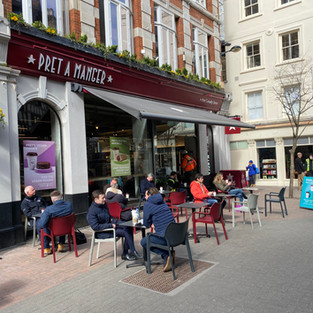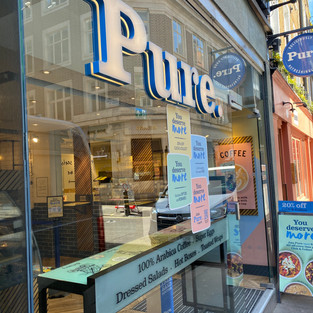Food-to-go in London: the new landscape
- Gavin Rothwell
- Apr 16, 2021
- 4 min read
As London gradually reopens, we take a closer look at the new environment and consider some of the implications of change.
Customer flows have shifted
We’re still very much in a period of turbulence. Customer flows have changed, and it's hard to know where they will end up. In London this week, the reduced footfall was probably most noticeable in the most central areas – Regent Street and Piccadilly Circus for example felt very quiet, Oxford Street and Tottenham Court Road felt slightly busier, while Granary Square (St Pancras) with extensive outdoor seating added on what was a cold if sunny day, was busy, despite lacking the abundance of streetfood stalls that are sometimes found there.
Leisure oriented outlets may become more important
But the dip in the most central areas may be the most predictable one to emerge from. Travel and leisure visits should return. And providing there is enough of a draw, there’s no reason why, as restrictions lift, they shouldn’t return to pre pandemic levels. But it’s hard to imagine a return to previous levels of commuting, which means some office locations will inevitably lose footfall.
Operators will therefore likely need to reassess their portfolios, to see whether current locations work in the new environment. Here’s how Pure MD Spencer Craig is looking at it.
"Consumer behaviour is completely distorted right now. So it’s difficult to plan how people will behave in the future. For us, as we reopen, it’s all about being the best we can be in the locations that we’re in. Once the distortions and restrictions are over, then we’ll look at the longer term strategy. Whether that involves opening in different locations or not, let’s see, that’s one of the things on the table."
This feels a sensible approach – customer flows will change further. Another consideration is that major new leisure draws – such as Eataly’s imminent opening on Bishopsgate – could further shift consumer flows. More broadly, if businesses do need to pivot more towards leisure spend, there may be format implications for leading operators, perhaps with a greater focus on seating areas and potentially scope for greater collaboration with more leisure oriented businesses. The Boxpark tie up with Bad Axe, the axe throwing experience, is one such collaboration. We expect more to come.
Creating great food-to-go experiences in-store that match the mission is key
Many city centre workers will have some element of choice in how they split their time between office working and home working. The coffee or smoothie they get in the morning, and the wrap or bowl they buy at lunchtime might not be a deciding factor, but it’s undoubtedly an influence. Having the right menu on offer to meet a variety of missions will therefore be important. It might also be important to offer online order and collect, depending on the operator and location. In short, consumers will be even less prepared to compromise. But that doesn't mean range proliferation, it just means the focus on missions and solutions - alongside the in-store execution across both product and service - will become more critical.
Businesses that help their customers lead better lives will be in pole position

The nature of how this is executed will depend on every individual business. The Brewdog approach around double offsetting CO2 emissions, and planting a tree – on sign up – for every four pack purchased, is one that’s impressed recently, but there are numerous other examples around. Another that stands out is Yoghurt Barn, a food-to-go chain in the Netherlands, which has recently taken its climate positive approach a step further by attaining B Corp status. MD Wouter Staal shared some valuable guidance over this in our recent subscriber report on Leaving Lockdown. In London and the UK in general, the opportunity for someone to take a lead is very much there.
Better connecting with customers will help drive longer term success
Businesses of all types have seen email become a more useful tool in customer communication over the past year. It's had to be when customers are unable to physically visit. But it’s less about communication, more about engagement, and value adding communications – or at least the chance to access them – feel like the best route through which to deliver this. We love the way Drop do this for wine, while from a foodservice perspective, Dishoom and Honest Burger are two that capture a great tone, both drawing out key strengths around what makes them special in the first place across their comms platforms.
If you've been stuck inside for the past year, it might be time to get out more. And if seeing, experiencing and learning from innovative formats is high on your priority list as you look to explore the future landscape, then we should talk. Our safaris equip you with fresh perspectives, and for our bespoke sessions, we can help develop and/or road test your plans for growth. We're here for you, get in touch gavin@foodfuturesinsights.com.










Comments